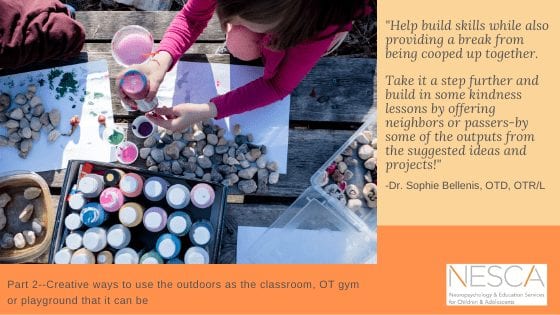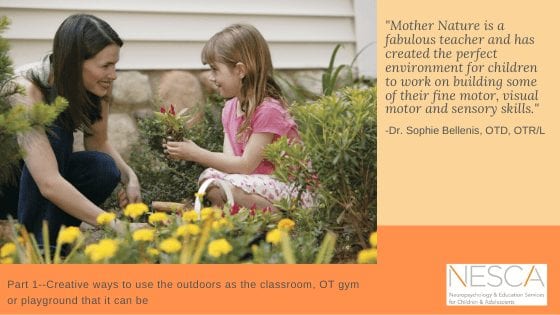
 By: Sophie Bellenis, OTD, OTR/L
By: Sophie Bellenis, OTD, OTR/L
Occupational Therapist; Real-life Skills Program Manager and Coach
In last week’s blog, we provided the first five ideas on how to teach and build OT skills by getting outdoors. This week, we bring the next installment of ideas to help build skills while also providing a break from being cooped up together. Take it a step further and build in some kindness lessons by offering neighbors or passers-by some of the outputs from the suggested ideas and projects!
- Make Fossils. This activity consists of finding unique and special treasures outdoors and making imprints of them back inside. First, find some small solid objects, such as rocks, small sticks, acorns, leaves or shells. This is a perfect activity to do after a nature scavenger hunt! Then have your children press these objects into playdough or plaster of Paris to make their own fossils. Children work on their fine motor skills as they roll out the plaster, pinch their objects and push them down to make an imprint. Try making this great playdough recipe together before you get started. For some extra creative options, to try include: incorporating small toys, such as dinosaur figurines or LEGOs or using cookie dough as a base, then eat your fossils for a snack!
- Make a Bird Feeder. There are many different creative ways to make bird feeders with your children. Choose a bird feeder that requires multiple fine motor skills and is appropriate for your child’s level! Two options are:
- Bagel Feeder – Start with a bagel. Help your child tie a string or piece of ribbon through the center hole of the bagel in a large loop. Next, have your child choose a topping to put onto the bagel. I generally suggest peanut butter! Have the child practice spreading this topping all over the bagel. Using a knife to spread such a thick, sticky substance is a pretty difficult fine motor task! Next have your child use their “pinchy fingers” (thumb and pointer finger) to pick up bird seed and sprinkle it on the peanut butter. The end product will be a bagel covered in peanut butter and bird seed that is ready to hang on a tree outside. Place it near a window and let your children watch the birds enjoy their creation!
- Cheerio Feeder – You may have heard that stringing beads is an excellent occupational therapy activity that promotes bilateral coordination, fine motor precision, motor planning and a pincer grasp. Consider making a bird feeder by stringing Cheerios (or any cereal with a hole in the center) onto a piece of string and hanging them in the trees. Birds will love to peck off the individual pieces as a snack.
- Paint Rocks or Shells. Painting rocks and other outdoor treasures is a great activity that allows children to be creative while using tools and practicing a functional grasp. Allow children to pick up the rocks and get messy to help promote some bilateral coordination!
- Draw with Sidewalk Chalk. While writing with chalk may seem very similar to writing with a pencil to us adults, for children who are just learning to manipulate a pencil, it can be a hugely different experience. Writing on the uneven ground provides tactile feedback. Holding a piece of chalk that moves with the contours of the ground requires increased hand strength. Children get to practice modulating how hard they need to push down on the chalk to make a solid line. If your child is hesitant to practice handwriting, try sneaking outside 5 or 10 minutes before them to create a few “sidewalk worksheets” for them to complete before they start to draw their creative masterpieces. For some children, there is a huge sensory piece to sidewalk chalk, as they work to tolerate the new texture and the feeling of chalk on their hands.
- Bring out the Bubbles. In occupational therapy, we often use bubbles to help children work on their oral motor skills. Children work to make their mouth into a round “O” shape and blow with enough force to create the bubbles themselves. Prompt your kids to pop bubbles by clapping their hands together. This helps to practice eye-hand and bilateral coordination. Next, have your child try to keep their eyes on one bubble as long as possible to practice visual tracking!
About the Author
Dr. Sophie Bellenis is a Licensed Occupational Therapist in Massachusetts, specializing in educational OT and functional life skills development. Dr. Bellenis joined NESCA in the fall of 2017 to offer community-based skills coaching services as a part of the Real-life Skills Program within NESCA’s Transition Services team. Dr. Bellenis graduated from the MGH Institute of Health Professions with a Doctorate in Occupational Therapy, with a focus on pediatrics and international program evaluation. She is a member of the American Occupational Therapy Association, as well as the World Federation of Occupational Therapists. Having spent years delivering direct services at the elementary, middle school and high school levels, Dr. Bellenis has extensive background with school-based occupational therapy services. She believes that individual sensory needs and visual skills must be taken into account to create comprehensive educational programming.
Neuropsychology & Education Services for Children & Adolescents (NESCA) is a pediatric neuropsychology practice and integrative treatment center with offices in Newton, Massachusetts, Plainville, Massachusetts, and Londonderry, New Hampshire, serving clients from preschool through young adulthood and their families. For more information, please email info@nesca-newton.com or call 617-658-9800.


 By:
By: 

 By:
By: 
Connect with Us